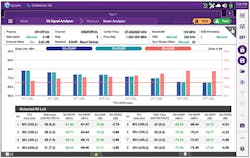Are You Really Ready to Deliver 5G?
Beware of Massive MIMO Deployment Challenges —
The promise of 5G technology is about to be realized, as network service providers worldwide prepare to deliver high-speed 5G services in 2019. Of course, this will not be as simple as it might sound. Deployment of 5G network infrastructure is introducing new challenges, not the least of which is the need for significantly greater capacity. Therefore, increasing spectrum efficiency is a key consideration when planning a 5G radio access network (RAN) capable of supporting countless new connected devices, things and applications.
With the use of millimeter wave (mmWave) spectrum, the 5G new radio air interface (NR) encompasses support for a much broader spectrum range, in both licensed and unlicensed frequencies. This means that 5G offers the potential for significantly higher data rates and high capacity throughput. Moreover, the short signal propagation characteristics of mmWave spectrum enable a larger number of antenna elements to be incorporated into a small form factor.
Traditionally, deploying a large chain of antennas has been nearly impossible due to lambda wavelength requirements. Massive multiple-input multiple-output (MIMO) transmission technology with 3D beamforming is designed to overcome these limitations, offering the potential to take full advantage of mmWave capabilities to greatly increase amplification and boost coverage.
Massive New Challenges
An important new feature of 5G NR is support for up to 128 steerable antenna elements, transitioning from static cell-centric coverage to dynamic user-based coverage. This multipath propagation technology can be used for beamforming in high-frequency mmWave bands to overcome propagation loss and maximize coverage across a much larger area. In the lower sub 6Ghz frequencies, MIMO enables capacity to be increased substantially with support for multi-user spatial multiplexing. In this way, better throughput and spectrum efficiency can be achieved, ensuring sufficient RAN capacity to meet increasing demand across 5G mobile and fixed wireless networks.
To achieve true beamforming, network technicians will need to identify the signal at beam level and test the performance of all the algorithms and handoffs, as well as validating the signal to interference ratio prior to service activation.
Yet, massive MIMO deployment is more than just an extension of existing MIMO techniques used in 4G and LTE networks. Now with massive MIMO and 5G NR, service providers can transmit and receive using a much larger antenna array by manipulating the phase and amplitude of the signals to dynamically direct coverage to a specific service area. To enable a substantial increase in capacity, the technology introduces multi-user spatial multiplexing, transmitting every byte on a different antenna stream in the real-time domain and freeing up the time slot for the next user. But this also leads to new complications during validation and activation, as well as more complex network operations and troubleshooting.
In this challenging RF environment, how can service providers ensure that user devices will be able to perform as expected? Plus, once the network goes live, how will network technicians validate if beamforming is working properly in the field? Validating over-the-air network performance is extremely important to ensure network quality, reliability and availability.
Navigating From Lab to Field
Validating new technology in the lab or field is always a daunting task, but this is particularly true for mission-critical 5G applications, such as connected cars, Smart Utilities or telemedicine. Up to this point, 5G network equipment manufacturers (NEMs) have been applying test and emulation solutions in the lab to mimic real-world field conditions, trying to assess the performance of network features within a loaded network environment. This allows NEMs to capture and resolve potential quality of experience issues under complex test scenarios in the lab before rolling out to the field.
InvisiLight® Solution for Deploying Fiber
April 2, 2022Go to Market Faster. Speed up Network Deployment
April 2, 2022Episode 10: Fiber Optic Closure Specs Explained…
April 1, 2022Food for Thought from Our 2022 ICT Visionaries
April 1, 2022Now, as we prepare for commercial deployments of 5G infrastructure, we’re moving beyond lab testing and field trials. But it’s important for service providers to ensure they can successfully deploy and turn up new 5G infrastructure without negatively impacting current customers. For those early market leaders planning to quickly roll-out new 5G services and enhancements in 2019, a best practices approach is to integrate lab verification with field testing to validate the performance of new network elements and guarantee the best possible network quality.
Due to the additional complexity of massive MIMO and 3D beamforming configurations, proper downlink testing requires validation of active antenna beam configuration as well as channel performance and quality. By performing a comprehensive system verification with a network simulation in the lab, technicians can identify any downlink (DL) anomalies, such as variability in behavior of the 5G next-generation base station (gNB), DL channel power, degraded DL modulation quality, beamforming performance or any antenna and cable issues. This saves a considerable amount of time, reducing unnecessary manual root cause analysis steps during field validation.
As service providers begin to roll-out 5G networks in the field, proper RAN validation will include thorough testing of the RF environment. With the introduction of multi-user spatial multiplexing in 5G, validating the gNB scheduling behavior is critical to achieving maximum throughput and enhanced cell performance using massive MIMO. This includes testing of dynamic beam tracking and switching performance to identify problems within each beam.
Like this Article?
Subscribe to ISE magazine and start receiving your FREE monthly copy today!
Without an accurate characterization of the active antenna beams, it’s nearly impossible to determine if each beam is performing correctly. Network technicians will need to identify the signal at beam level and test the performance of all the algorithms and handoffs, as well as validating the signal to interference ratio prior to service activation. This is critical because the beam indexes need to be at a certain RF level before they can be recognized by user devices. True beamforming can’t be achieved if this signal-to-noise threshold is not met, thereby limiting potential coverage.
Moreover, as many service providers will likely overlay new 5G networks in existing LTE systems, operating a mix of technologies at both higher and lower frequencies, a coverage imbalance between uplink and downlink could be a common scenario. New testing procedures should be adopted to monitor key downlink configurations and performance indicators:
• gNB channel bandwidth
• Channel center frequency
• Correct Cell IDs
• Modulation quality
• Transmit power
• Active antenna beam performance
• Channel stability
Once beamforming characteristics, quality, and impairments, are measured and recorded in the field, these results can be stored for further analysis and saved as benchmarks to simplify troubleshooting and identification of the root causes of poor RF performance in the future.
Betting on a 5G Future
Service providers worldwide are making significant investments of time and money in their bid to offer profitable new 5G services. While massive MIMO and antenna beamforming are key capabilities that will enable the full promise of 5G to be realized, these complex technologies contribute to a variety of new challenges. As a result, more rigorous test and measurement processes should be adopted to ensure that you are getting the most value from your investment and delivering optimized customer experience.
About the Author






